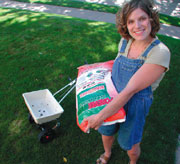Don't "P" on Your Lawn

Photo from www.lawntolake.org
The spring weather has many of us poring over seed catalogues and hankering to get out gardening. Here are a few "clean lake" tips to follow to ensure that the investments you make in your property stay there rather than running off into the lake:
- Don't apply fertilizer in the spring. Early fall is the best time to fertilize in the Champlain Valley. So hold off on adding anything to your soil now and use the time instead to get a soil test done so you know what - if anything your soil needs. Contact Cornell Cooperative Extension in New York and UVM Extension in Vermont to obtain soil test kits.
- Don't use fertilizer with phosphorus. Studies indicate that the majority of northeastern lawns have more than enough phosphorus. If you do use fertilizer, make sure to buy a bag of the phosphorus free stuff. The three numbers on the fertilizer bag indicate the Nitrogen (N), Phosphorus (P), and Potassium (K) content. A "zero" in the middle means it is phosphorus-free. Lawns rarely need extra potassium (K) but adding some won't affect water quality.
- Plant grass seed on existing lawns in the fall and spring. Use a grass mixture that does well in the area and leave legumes, such as common white clover, among the grass to add nitrogen to your lawn naturally. These practices will encourage strong root growth and enable the grass to outcompete weeds.
- Mow to maintain a height of 3 to 4 inches. Cut off no more than 1/3 of the grass blade and leave the clippings on the lawn to add nutrients and organic matter.
- Sweep any clippings and fertilizer off paved or hard surface areas. This will keep nutrients on your land instead of in the lake.
LCC is a partner in the Lawn to Lake program. Check out the Lawn to Lake website for more information on:
